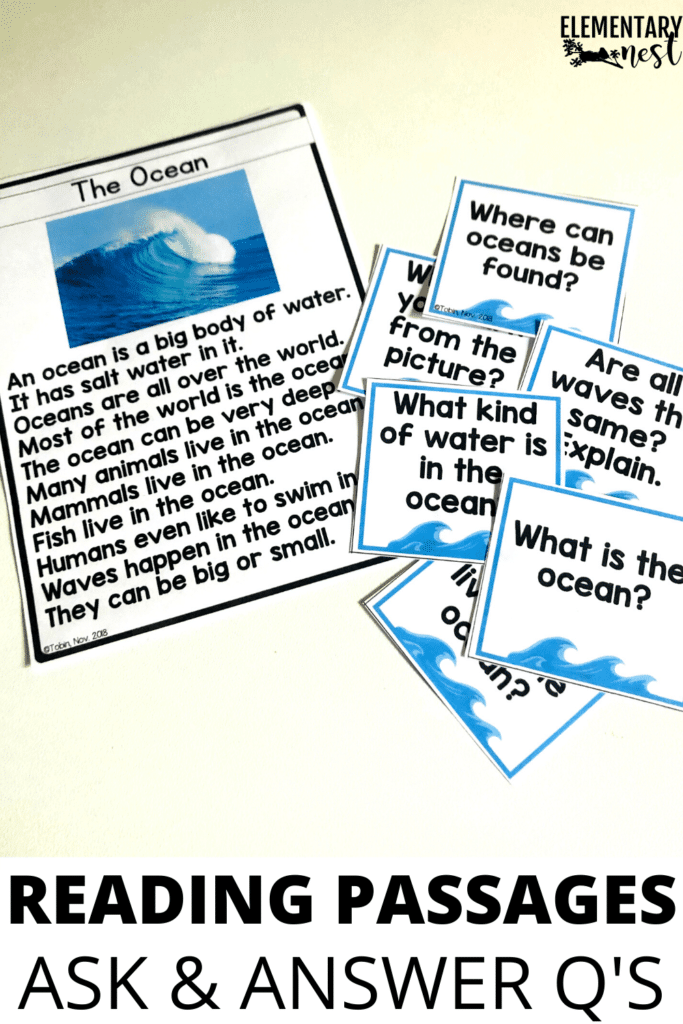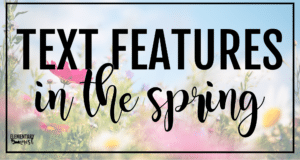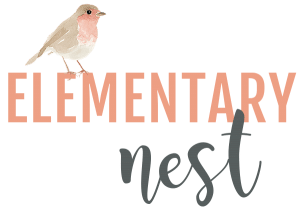
This blog post focuses on teaching Kindergarten informational text skills. Informational text is nonfiction and allows students to learn more about types of text, asking and answering questions, main topic, making connections, context clues, and more. These skills are important for students to master as they begin to think critically about nonfiction informational text. The Kindergarten nonfiction activities referenced in this blog post all align with a common core Kindergarten informational text standard.
Kindergarten Informational Text Standards:
- RIK.1: With prompting and support, ask and answer questions about key details in a text.
- RIK.2: With prompting and support, identify the main topic and retell key details of a text.
- RIK.3: With prompting and support, describe the connection between two individuals, events, ideas, or pieces of information in a text.
- RIK.4: With prompting and support, ask and answer questions about unknown words in a text.
- RIK.5: Identify the front cover, back cover, and title page of a book.
- RIK.6: Name the author and illustrator of a text and define the role of each in presenting the ideas or information in a text.
- RIK.7: With prompting and support, describe the relationship between illustrations and the text in which they appear (e.g., what person, place, thing, or idea in the text an illustration depicts).
- RIK.8: With prompting and support, identify the reasons an author gives to support points in a text.
- RIK.9: With prompting and support, identify basic similarities in and differences between two texts on the same topic (e.g., in illustrations, descriptions, or procedures).
Let’s Look at the SEQUENCE of This Blog Post
- Pace out your year
- Start with WHAT nonfiction is
- Make sure it’s all teacher-led
- Introduce the 5Ws
- Teach them to use images
- Use Main Topic early to help practice that skill
- Practice, practice, practice
Pace Out Your Year to Hit All 9 Nonfiction Standards
Before you start teaching your Kindergarten ELA units, it is a good practice to use a pacing guide to map out your year. This helps you account for all the standards you need to teach, including your nonfiction standards. Your students will build on skills throughout the year as you introduce new topics.
I have created a free Kindergarten ELA pacing guide to help plan out your instruction and standards ahead of time. This pacing guide outlines all six Kindergarten ELA domains and links to my resources for each. If your school already has a pacing guide, feel free to use this as a reference and use the resources included where you see fit.
(Link: Free Pacing Guide)
Spend Time Determining What’s Nonfiction and Fiction

(Source: Types of Texts RLK.5)
To begin your informational text unit, it is important to help students determine what is fiction and nonfiction. Using these anchor charts will help your students compare and contrast the types of text using both the descriptions and pictures. They must understand this concept before moving on. These anchor charts are found in my literature bundle linked above.

(Source: Types of Texts RLK.5)
After studying the differences between fiction and nonfiction, it is time for your students to put that knowledge into action. This book sort activity, found in my literature bundle, is the perfect way to practice. They will use the text and picture clues to sort the fiction texts and nonfiction texts.
All Teacher-Led
Any of your instructional-based work should be teacher-led and guided. Giving them instructional material will require assistance. When teaching these more complex informational text standards, it is important for the teacher to lead instruction and activities. These are essential skills, so providing the students with ample modeling, guidance, and feedback is key. As you work through the Kindergarten nonfiction activities referenced in this blog post, you may begin scaffolding instruction as your students gain understanding.
Then, Introduce Simple 5W Questions

(Source: Ask & Answer Questions RIK.1)
As you dive into the nonfiction text skills, the main focus is the skill, not reading strategies. Therefore, beginning instruction with images and questions is beneficial. Using nonfiction activities such as these question cards with corresponding images allows your students to think deeply about the questions and correct answers. They will learn more about asking 5W questions, such as who, what, when, where, and why questions.

(Source: Ask & Answer Questions RIK.1)
The standards-based passages, books, and graphic organizers used for nonfiction text activities should be presented with direct instruction. This can be done in a whole group or teacher-led small groups. This is not the time for partner work or individual work. The teacher should be facilitating these lessons and activities in order to effectively teach the concept to students.

(Source: Ask & Answer Questions RIK.1)
Teaching informational text can be tricky, so using 1-2 read alouds per day is helpful. Mixing up read alouds by using books and passages gives the students experience with both kinds of text. As you read, pause on each page to ask guiding questions. Consistent reflection throughout the read alouds will help your students think critically about the nonfiction text and skills.
Rely Heavily on Images

(Source: Pictures and Images in a Nonfiction Text RIK.7)
With nonfiction read alouds, it is important to rely on the images to answer questions and explain what is being learned. This picture walk activity is a great way to do this and should be used with all read alouds. The students will recall facts that they learned from the images in the nonfiction text as well as practice writing the title, author, and illustrator information. Using the picture walk activity is effective in reviewing the read aloud and working on comprehension.

(Source: Pictures and Images in a Nonfiction Text RIK.7)
This true/false nonfiction activity is effective when studying images. Students will be able to differentiate true examples from false non-examples. This will allow them to point out when an illustration does not match the description. Again, do not focus on the reading skill here, but instead, make the nonfiction skill the priority.
Teach Main Topic Early

(Source: Main Topic of a Nonfiction Text RIK.2)
Another important nonfiction standard is teaching the main topic. Beginning with images is a good way to start. The images will help the students determine what the main topic is. The simple sentences in this Kindergarten nonfiction activity will help the students make the connection between the text and image, thus, helping them understand the concept of main topic. From here, you can expand into key details that support the main topic using the images.

(Source: Main Topic of a Nonfiction Text RIK.2)
Again, using activities like this that show examples and non-examples is effective for students. This activity focuses on key details and how to find them. Students will determine whether the image, main topic, and key detail make sense or not. This sort activity is a great way for students to practice this skill all while staying engaged.
This activity also serves another purpose. It helps students sum up the text in a couple words. The images are helpful for the students in explaining what the text is mainly about in a succinct manner.
Practice Daily

(Source: Main Topic of a Nonfiction Text RIK.2)
With these informational text standards, daily practice is crucial. Not only does it help the students grasp the concepts, but also retain and build on them as time goes on. Use these Kindergarten nonfiction activities for small group and whole group practice to keep these skills fresh. Also, make sure you’re giving them multiple ways to practice these skills. Work them into partner time, centers, independent reading time, and more.
Suggested Resources to Make Your Life Easier
All of the activities found throughout this blog post are part of my Kindergarten RI standards-based resource bundle. You can purchase the bundle as a whole or each standard unit separately.
Thanks for reading this blog post about nonfiction in Kindergarten. If you’re looking for more deep-dives into nonfiction standards, check out these blog posts:



















